
- Research
- 06/06/2019
New interaction between thin film magnets for faster memory devices
Researchers from TU/e, Germany and South Korea discovered a new interaction between thin film magnets, which lays the foundations for faster and robust memory devices with larger data capacity. Their results were published in Nature Materials this week.
Nowadays, we ubiquitously stream videos, download audiobooks to mobile devices, and store huge numbers of photos on our devices. Thus, the storage capacity we need is growing rapidly, and researchers are working hard to develop new data storage options. One possibility is represented by the so-called ‘racetrack memory device’, in which data is stored in nanowires in the form of oppositely magnetized layers (‘domains’).
A research team from TU/e, Johannes Gutenberg University (JGU) (Germany), Peter Grunberg Institute (PGI), Daegu Gyeongbuk Institute of Science and Technology and Sogang University (both in South Korea), has now made a discovery that could significantly improve these racetrack memory devices. Instead of using individual domains, in the future one could store the information in three-dimensional spin structures, making memories faster, more robust and providing a larger data capacity.

New interaction
The research team was able to demonstrate a hitherto undiscovered interaction, which occurs between two thin magnetic layers separated by a non-magnetic layer. Usually, spins align either parallel or antiparallel to each other. This would also be expected for such two separate magnetic layers. However, in this work, the researchers have been able to show that the spins in the two layers are twisted against each other. More precisely, they couple to align perpendicular, at an angle of 90 degrees with one another.
Reinoud Lavrijsen, assistant professor at Applied Physics: "This breakthrough discovery opens up the possibility of designing various new three-dimensional spin structures, which in the long term could lead to new magnetic storage units. The identified interaction, however, is at this moment not strong enough for applications, but we are committed to engineer and optimize this further so that it can be used in future 3-dimensional data storage and logic devices."
Joint effort
This research is - in the words of Lavrijsen - ‘an excellent example of collaboration between world-class facilities and expertise’. It was initiated in 2014 by Dong-Soo Han, former Post-Doc researcher at TU/e, in collaboration with professor Henk Swagten within the group of Physics of Nanostructures. The materials used for the study were provided by the NanoAccess research laboratory at the TU/e, and they were grown into thin film magnets by Han and PhD student Youri van Hees, under the supervision of professor Swagten and Dr. Lavrijsen. The new interlayer coupling interaction was theoretically explained through theoretical calculations performed by project partners at PGI. Researchers from JGU examined a number of different combinations of materials grown in multi-layers.
Discussion